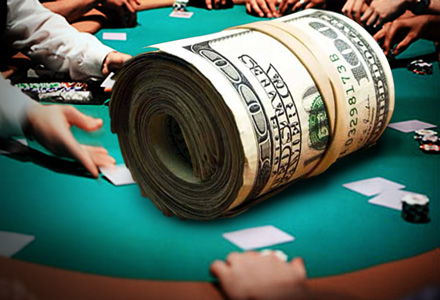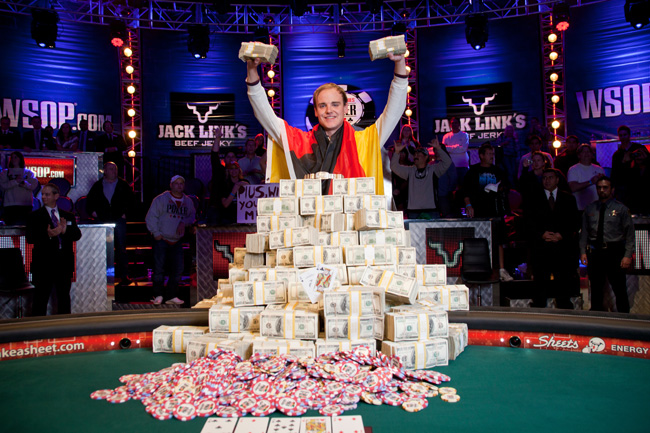 Back when tournament poker was invented in 1970, $10,000 was a lot of money. Today that number sounds like a lot more than it actually is, thanks to inflation – $10,000 in 2011 dollars is only worth about $1,724 in 1970 dollars – yet $10,000 has continued to be the gold standard for major tournament buy-ins since the very beginnings of the poker boom. When High Roller eventscame along they tended to have buy-ins of $25,000 – a lot compared to your standard tournament today, but still worth less than $5,000 in 1970 dollars. Only in the last few years with the so-called “Super High Roller” tournaments have we surpassed the kind of high-rolling those original tournament players in Las Vegas were engaged in.
Back when tournament poker was invented in 1970, $10,000 was a lot of money. Today that number sounds like a lot more than it actually is, thanks to inflation – $10,000 in 2011 dollars is only worth about $1,724 in 1970 dollars – yet $10,000 has continued to be the gold standard for major tournament buy-ins since the very beginnings of the poker boom. When High Roller eventscame along they tended to have buy-ins of $25,000 – a lot compared to your standard tournament today, but still worth less than $5,000 in 1970 dollars. Only in the last few years with the so-called “Super High Roller” tournaments have we surpassed the kind of high-rolling those original tournament players in Las Vegas were engaged in.
One of the earliest of these tournaments was the $100,000 Challenge at the 2006 Aussie Millions. It drew 10 players and was won by John Juanda, who took home $1 million. By 2011 interest (and the poker economy) had grown enough to support a pretty incredible field of 38 players. That kind of success led the tournament’s organizers last year to to put on a $250,000 Challenge. That drew 20 players and was won by Erik Seidel, who picked up the same kind of cash ($2.5 million) that most other players will only see if they win a particularly large EPT or WPT tournament.
Super High Roller tournaments are great for a number of things. More than anything they’re excellent fun for poker fans who like to see their favorite players on television, battling it out over huge sums of money with other players of the same caliber. They’re also great for making big, attention-grabbing headlines – and the more money there is at stake, the better. But at the bottom line, what Super High Roller tournaments are really great for is exploding career tournament winnings numbers, which is fantastic for making top players even more promotable in these inflationary times.
 The value of setting the big-money sponsored pros apart from the masses of tournament-poker millionaires created over the last decade shouldn’t be underestimated. Much of tournament poker’s appeal is that anyone can win, and by this point just about everyone has won thanks to the democratizing juggernaut that is the WSOP Main Event. When you filter the all-time money list to only include open events with buy-ins of less than $50,000 – excluding the made-for-TV events and High Roller tournaments – 19 of the top 100 players who have ever won a single dollar playing poker are people whose primary (and sometimes sole) poker accomplishment is a final table appearance in the WSOP Main Event during the last decade.
The value of setting the big-money sponsored pros apart from the masses of tournament-poker millionaires created over the last decade shouldn’t be underestimated. Much of tournament poker’s appeal is that anyone can win, and by this point just about everyone has won thanks to the democratizing juggernaut that is the WSOP Main Event. When you filter the all-time money list to only include open events with buy-ins of less than $50,000 – excluding the made-for-TV events and High Roller tournaments – 19 of the top 100 players who have ever won a single dollar playing poker are people whose primary (and sometimes sole) poker accomplishment is a final table appearance in the WSOP Main Event during the last decade.
That single ten-year span of one tournament’s final table payouts so heavily dominates the money rankings that the all-time top 100 money list leaves out 709 other people who have won at least $1 million playing tournament poker. It doesn’t include some of the biggest names in poker history, like Chip Reese and Stu Ungar. (Neither was primarily a tournament player, but both earned substantial sums from tourneys.) It also doesn’t include a number of highly accomplished players of more recent times like Annette Obrestad and Eric Baldwin. In other words, it’s harder than ever to stand out from the crowd just by being excellent at poker. Throw in a few $4 million scores against fields of less than 50 players, though, and the picture begins to change.
That alone means these events are unlikely to go away as long as poker rooms are still sponsoring players. The number of players who take part in these tournaments, however, doesn’t appear likely to grow very much in the near future. The $100,000 Challenge was on the Aussie Millions schedule again for 2012 – it ran last week and drew just 22 entries compared to last year’s 38. The $250,000 Challenge is also on the schedule – it begins today and won’t likely top last year’s field of 20. Similarly, the 30-player field for the PokerStars Caribbean Adventure’s $100,000 Super High Roller event was down from its inaugural 2011 field of 38.
The downswing can in large part be attributed to the overall state of the poker economy, which isn’t nearly as flush as it was pre-Black Friday. But there are other factors at play, too. For starters, the crowded international tournament calendar these days means there’s a lot of competition among tournament series; the Aussie Millions and the PokerStars Caribbean Adventure don’t actually take place at exactly the same time, but they both take place during the month of January so they still end up competing with each other for players’ buy-ins. If there were only one of these events per year the field might actually grow quite a bit, but the more of them there are the smaller they will be since they’re placing a high level of stress on the poker economy. There’s also no way for anyone who to qualify for them through any kind of satellite process, which is one of the easiest ways to help a tournament field swell. And as long as the current online poker situation continues in the United States – where most of the world’s winningest tournament players still reside (for the time being) – the chance of serious growth in Super High Roller fields has a pretty low ceiling.
- The Mega-Rich (Dan Shak, David Steicke, et al.) – These guys are going to play in the biggest games around regadless of the price tag – and in fact, the higher the price tag the more likely they are to play, under the same logic as Andy Beal taking on the Corporation: the more you take a player out of his comfort zone, the more likely he is to make mistakes you can capitalize on. Smart thinking, but there just aren’t that many of these guys out there, so they’ll never make up a truly significant part of the tournament’s field.
- Sponsored players (Daniel Negreanu, Tony G, Viktor Blom, Jonathan Duhamel, et al.) – The most popular pros need continual success to stay where they are, and there’s no better route to success in tournament poker than small fields. (It’s much easier to beat a field of 30 than a field of 300 or 3,000.) When you keep the buy-in high, winners still earn the kind of money they might take down in the average $10K tournament. As long as these guys keep their sponsorships, they’ll play in every big event there is – especially if they’re on Team PokerStars and the event is being held during the PCA or on one of the many global poker tours owned by their sponsor.
- Unsponsored elite tournament players (Erik Seidel, Michael Mizrachi, et al.) – Whether it’s from their own pockets or from other players who are willing to back them, these are some of the only poker players in the world who have access to the kind of money it takes to regularly enter tournaments with buy-ins of $100,000 and up. You could probably also include Phil Ivey in this category if the whole Full Tilt mess ever gets cleaned up.
- Players on hot streaks – Some players go on a hot streak, winning or making the final table of several big events in the course of a year. They’re either willing to dip into their own newly flush bankrolls, trying to play the rush, or they’re able to raise the buy-in by selling off action to other players who wouldn’t necessarily buy in for such a tournament themselves. This category has probably the smallest membership of all, given that it’s dependent on somebody a) doing really well for an extended period of time and b) also having the sort of mindset that allows one to plunk a quarter-million dollars down for a poker tournament.